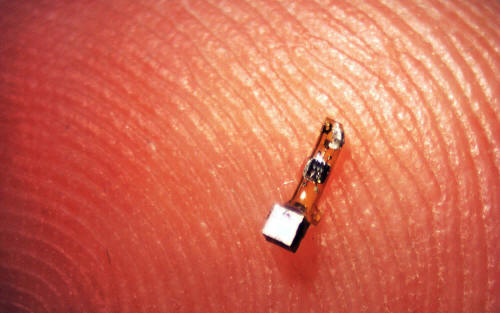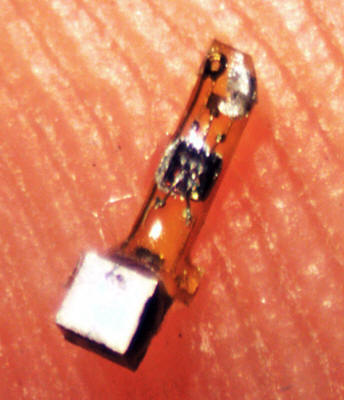|

by Ian Johnston
August 03, 2016
from
TheIndependent Website


Tiny
implant could connect
humans and machines like never
before.
Invention of 'neural dust'
could mean people will be able
to communicate with computers
using the power of their mind.
Great health
benefits are always highlighted, while the dark side
is never mentioned.
Neural dust
could easily be used for complete mind/body control,
erasing and implanting memories, implanting
emotional responses, etc.
Alternatively,
Transhumans hope to use neural dust to download the
content of their brain to a computer, thus assuring
immortality.
Source
A tiny implant the size of a grain of sand has been created that can
connect computers to the human body without the need for wires or
batteries, opening up a host of futuristic possibilities.
The devices, dubbed "neural dust", could be used to continually
monitor organs like the heart in real time and, if they can be made
even smaller, implanted into the brain to control robotic devices
like prosthetic arms or legs.
It is believed they could help treat conditions like epilepsy by
stimulating nerves and muscles, help people with incontinence
control their bladder and even suppress appetite.
They could also potentially either be
used to prompt the immune system into action or reduce inflammation.
One of the inventors, Professor Michel Maharbiz, of
University of California, Berkeley, said:
"I think the long-term prospects for
neural dust are not only within nerves and the brain, but much
broader.
"Having access to in-body telemetry
has never been possible because there has been no way to put
something super-tiny super-deep [in the body].
"But now I can take a speck of nothing and park it next to a
nerve or organ, your [gastro-intestinal] tract or a muscle, and
read out the data."
Ultrasound vibrations, which can
penetrate almost every part of the body, are used to power the
sensors, which are about a millimeter across.
They contain a special crystal that converts ultrasound into
electricity to power a tiny transistor. If there is a voltage spike
in a nerve or muscle fibre this alters the vibration of the crystal,
changing the way the sound echoes back to an ultrasound receiver.
So far, experiments have been carried out on muscles and the
peripheral nervous system of rats, but the researchers believe the
dust could also work in the central nervous system and brain to
control prosthetics.
This can already be done using brain implants, but these require
wires that go through a hole in the skull, potentially allowing in
infection or movement of the sensor within the brain.
They must also be replaced after about
one to two years.
The researchers are currently building neural dust that could last
in the body for more than 10 years. And because they are wireless
there is no need for holes to remain in the skull.
Professor Jose Carmena, a neuroscientist at Berkeley, said:
"The technology is not really there
yet to get to the 50-micron target size which we would need for
the brain and central nervous system.
"Once it's clinically proven, however, neural dust will just
replace wire electrodes. This time, once you close up the brain,
you're done."
However he added:
"The beauty is that now, the sensors
are small enough to have a good application in the peripheral
nervous system, for bladder control or appetite suppression, for
example."
A paper about the research (Wireless
Recording in the Peripheral Nervous System with Ultrasonic Neural
Dust) was published
in the
journal Neuron.
|



